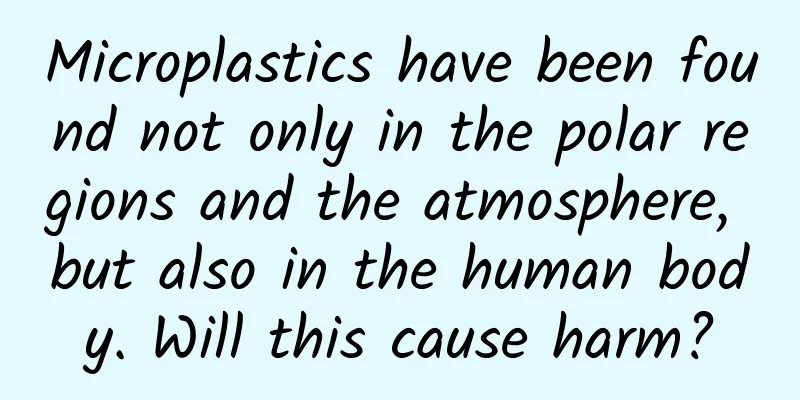Microplastics have been found not only in the polar regions and the atmosphere, but also in the human body. Will this cause harm?

|
In March this year, many people must have read a news report that microplastics were found in human blood. This may sound a bit scary at first, but if you think about it carefully, it doesn’t seem strange. Human blood is not a foreign land and circulates with the outside world, so how can there be no microplastics? Previously, there have been reports that microplastics can be detected in feces, which also surprised people. Many people are worried about whether microplastics in the blood will cause any harm? For now, we can only say that we don’t know. Our research on microplastics is still in its infancy. In fact, even in the entire field of plastics, our research on its hazards is not very mature. There are many reasons for the lag in research. One of them is that there are too many types of plastics. Compared with traditional materials such as steel and ceramics, the speed of renewal is relatively fast, and the research content cannot keep up. Of course, the more important reason is social reasons, which will not be discussed in depth here. There are two main aspects of the harm that plastic does to humans: one is the harm to the human living environment, and the other is the harm to human health. As the title suggests, we have now found traces of plastic in blood, atmosphere and polar regions. The biggest puzzlement of this issue is that plastic has become part of the global material cycle, and it may bring new patterns to the earth's cycle. It’s not easy to understand this abstract statement, so let’s talk about something that once happened on Earth. Many people have probably heard of the term "Carboniferous". In geology, it refers to the period of time between 290 million and 360 million years ago, spanning tens of millions of years, with slight differences between different data. However, there is no dispute about the characteristics of the Carboniferous period. As the name suggests, a large amount of coal was formed. More than half of the coal we dig today comes from this period. Why is it not too early or too late, but at this time? Modern science has concluded that it has a lot to do with the substance called lignin. When tall trees first evolved, the Earth encountered a very thorny problem. The trunks of tall trees are mainly composed of cellulose and lignin. Cellulose is an old face, but lignin is a new substance. The molecular weight of lignin is neither too big nor too small, and it cannot be called a macromolecule, but it is not as small as glycerol. For the microorganisms at that time, this molecule could not be metabolized and could only accumulate continuously. Caption: A large part of today's coal mines are products of the Carboniferous period As a result, the Earth's carbon cycle was disrupted, with less and less carbon dioxide in the atmosphere, but more and more carbon converted into lignin by trees, which was eventually buried deep underground and turned into coal. This cycle was not restored until hundreds of millions of years later, because microorganisms that could decompose lignin finally evolved on Earth. During this period, the atmosphere lacked carbon dioxide, but oxygen was much richer than it is now, so many species were eliminated, and the problem of climate change was much more severe than it is now. It can be said that tiny lignin has changed the face of the entire earth. This is of course an extreme case, but it tells us how important the material cycle on Earth is, especially carbon. Our ecosystem is now as helpless in the face of plastic as it was in the face of lignin. Therefore, when talking about environmental protection, people often ask, if there is no degradable plastic, then what is the best way to deal with the current plastic? Contrary to what many people imagine, incineration is the most environmentally friendly approach, because this method forces plastic to re-enter the earth's cycle in the form of carbon dioxide and water. On the contrary, as we find that more and more plastics are entering the earth's cycle in their original form, we have to worry about whether those plastic bags floating on the polar regions will remain there forever. At present, it is very likely to be so. In the scale of our human life span of just a few decades, it is actually difficult to give an accurate answer to what the consequences are. At present, we can only superficially study some events with direct cause and effect, such as plastic rings in the ocean suffocating turtles. When I say "superficial", I don't mean that such research has no value. It is valuable, but only for individuals. For human beings, we can't even find the entrance to study big problems now, which is more serious than saying any specific harm. We have all heard of the popular expression of the "butterfly effect": a butterfly flaps its wings in the forests of South America, and a storm blows up in the Pacific Ocean. Of course, a butterfly is not that powerful, but its disturbance may have a significant impact on the results, because many disturbances will continue to amplify their effects in subsequent evolution. We now use "symmetry breaking" to describe this phenomenon. For example, all life on Earth only digests D-glucose, and is not interested in its enantiomer L-glucose. This is nothing more than the initial "symmetry breaking". If there is no symmetry breaking, then there should be the same number of organisms on Earth that digest D-glucose and L-glucose. Therefore, in the spirit of science, we cannot underestimate any cycle of plastic disturbance, not because of its direct consequences. I can even speculate that the little plastic found in the polar regions has almost no chance of causing penguins to choke to death, but we cannot rule out that the consequences of this disturbance will lead to the extinction of the species Homo sapiens. After talking about the impact on the environment, let’s talk about the harm of plastic to health. The health hazards of plastic itself are actually very limited. The plastics we use nowadays are all based on polymer materials. For example, the seven common plastics include polyethylene (PE), polypropylene (PP), polyvinyl chloride (PVC), polystyrene (PS), polyethylene terephthalate (PET), etc. For non-professionals, it is meaningless to remember these terms, and even the abbreviations do not need to be paid much attention to. What we need to know is that these substances themselves are actually not harmful. Many unknown substances may cause harm to the human body after ingestion, but we now know that the premise for causing harm is that the substance will undergo a chemical reaction in the body. For example, the so-called allergy is actually a reaction between the immune protein in our body and the allergic substance, inducing an excessive immune effect. Think about plastics. Even microorganisms cannot metabolize them, which means that substances that can react chemically with these things are very rare in living organisms, so the possibility of them causing harm is extremely low. For example, when we eat a simple breakfast, we will inevitably use plastic bags to pack food. If we really bite into the plastic bag and eat it, at most we will excrete it as it is. Unless we eat the whole bag and end up with intestinal obstruction, that is another matter. However, when plastics are made into finished products, they often require some additives, and these additives may be problematic. I have listed a few common questions that can also help you distinguish in your daily life: (1) Polyvinyl chloride (PVC, triangular identification number 3): Why is it said that polymers generally do not have problems? This "generally" mainly excludes polyvinyl chloride and the polycarbonate and epoxy resin mentioned below. PVC may decompose under improper use conditions (such as high temperature or direct sunlight). Since the system contains chlorine, the product will be more complicated. Therefore, PVC is no longer allowed to be used in food packaging, including polyvinyl chloride cling film, which is also not allowed to come into direct contact with cooked food. Of course, the hidden dangers of polyvinyl chloride itself are actually very small. It is banned more because it is a plastic that needs to be added with plasticizers (plasticizers). More than 90% of plasticizers in the world are used in PVC plastics. Among plasticizers, phthalates are often used, which may be harmful to the human body (research results are unclear). Therefore, the abbreviation PVC should still be remembered. Use it if you want to, but don't use it in kitchen systems, such as extending the hose of the faucet, tablecloths, coasters, etc. It is better to avoid it as much as possible. (2) Polycarbonate (PC, triangular identification number 7): This plastic has been very popular in the past decade because it was restricted by the European Union and China has also made some follow-up efforts. Its main problem is that it uses a substance called bisphenol A (BPA), which is an environmental estrogen. In other words, it is not a hormone itself, but it can act as a hormone in the body. Current research shows that it is likely to be related to problems such as early puberty and adolescent obesity. However, it is also an excellent transparent plastic, especially suitable for baby bottles. If you are still choosing baby bottles, it is recommended to avoid it and either choose one with the words "BPA free" or directly choose other plastics, such as PPSU. (3) Epoxy resin (EP): This plastic is most commonly used in floor paint. The problem is that bisphenol A is used in the raw materials, which may have residues. The main opportunity for food to come into contact with EP is the internal coating of cans. Therefore, canned drinks may be the culprit for excessive BPA in some people's bodies. There is no need to pay too much attention to this plastic, as it is rarely used in other eating scenarios. (4) Polystyrene (PS, triangular identification number 6): Polystyrene is divided into two categories: one is transparent polystyrene, which is often used in cups on airplanes; the other is expanded polystyrene, which is often used in bucket instant noodles. In the past, we were more concerned about the hazards of expanded polystyrene, mainly because the foaming agent may leave residues. However, the current technology can already overcome this problem. (5) Polyethylene terephthalate (PET, triangular identification number 1): Commonly used in mineral water bottles, it is basically harmless, but it is not recommended to drink highly acidic beverages. This is because some PET manufacturing processes still use traditional antimony catalysts. Antimony is a well-known element because its element symbol is Sb. Excessive intake can also cause certain harm. Acidic beverages are more likely to extract antimony from beverage bottles. Therefore, acidic beverages in PET bottles should be avoided as much as possible. Here, I recommend soda in glass bottles. Most small shops also provide glass bottle recycling services, which ensures your health while also recycling resources to the best of your ability. By the way, PET recycling is still doing very well now. (6) Polytetrafluoroethylene (PTFE): Trade name Teflon, the coating of non-stick pans. It is harmless in itself, even if the temperature is over 200 degrees. It is also commonly known as the king of plastics. Ordinary nitric acid, sulfuric acid, and even aqua regia cannot do anything to it, so its harm is basically non-existent. However, if you have seen the movie "Dark Waters", you may have a deep impression of this plastic. In fact, "Dark Waters" investigates the production process, in which a substance called perfluorooctanoic acid (PFOA) is used, which is very harmful to organisms. Seriously speaking, because PFOA is used in the production process, no one dares to guarantee that PTFE is completely safe, but as far as non-stick pan technology is concerned, there is no particularly ideal alternative at present, and PTFE is still the best solution for the time being. (7) Finally, let’s talk about polyethylene (PE, triangular identification numbers 2 and 4) and polypropylene (PP, triangular identification number 5). They are both very ideal plastics for food packaging. In the production process, they use some catalysts, involving aluminum and titanium, and the actual harm is really limited. No. 2 PE is HDPE, which is a hard plastic mainly used for packaging such as shampoo bottles. It generally does not come into contact with food and has more additives. No. 4 PE is LDPE, which is mainly used for disposable plastic bags. Not to mention No. 5 PP, many people know that it is a special plastic for microwave ovens, so the safety of these two types of plastics is very high. However, to be honest, PP and PE are also among the most troublesome types of plastic degradation. Regarding the harm of plastic, although the research progress is still in its early stages, there is still a lot to say. If I have to give a simple conclusion, I would like to say that on the one hand, we should not panic because of the health problems that plastic may cause, and most of the hidden dangers publicized in the media are exaggerated; but on the other hand, we should not underestimate the destructive effect of plastic on the environment, which is by no means just the superficial phenomenon we see now. In a nutshell, the real harm caused by plastic is measured in hundreds, thousands or even tens of thousands of years. The results we can see or predict at present are very limited. I hope that our generation can establish reliable models to more effectively guide the production, application and recycling of plastics. Produced by: China Science Expo x Zhihu Author: Sun Yafei (Excellent Answerer of Zhihu Chemistry) The article only represents the author's views and does not represent the position of China Science Expo This article was first published in China Science Expo (kepubolan) Please indicate the source of the public account when reprinting Please indicate the source of the reprint. Reprinting without authorization is prohibited. For reprint authorization, cooperation, and submission matters, please contact [email protected] |
>>: June stargazing guide: Supermoon and meteor showers add color to the most beautiful Milky Way
Recommend
Short video advertising materials and shooting techniques!
1. A huge material consumption machine In early 2...
Guangzhou WeChat Mini Program Mall Ranking, What are the factors that affect the ranking of mini programs?
Open the APP on your phone, no matter which e-com...
No New Year's Eve in 2022? It will be absent for the next five years
Did you find it? There will be no New Year's ...
Chen Changwen talks about entrepreneurship: Entrepreneurship is all about traffic (electronic document)
Course Catalog: Chen Changwen: The creation of th...
Huawei sues Samsung for patent infringement; the mobile phone industry is already a "three-legged race"
On the 25th, Chinese technology giant Huawei sued...
Can you see the vortex of Coriolis force in the toilet?
Produced by: Science Popularization China Produce...
Gartner: Opt-out rates for mobile app tracking will drop from 85% to 60% by 2023
According to data released by market research fir...
Price inquiry for the development of Kashgar Fresh Food Mini Program. How much does it cost to produce the Kashgar Fresh Food Mini Program?
How much does it cost to join a fresh food mini p...
2020 Advertising Industry Survival Guide
In recent years, remarks such as "4A is dead...
Hu Q&A丨Why do nuclear submarines run so fast?
Where do nuclear submarines run faster? First, ru...
How to promote APP? APP promotion tips!
Mobile devices have become the most important too...
Snapchat porn leak source found
An anonymous developer of a third-party Snapchat ...
Will acquired changes affect gene inheritance?
The reason why humans have been able to reproduce...
King's Counterattack: Use AI to play WeChat Jump Jump, automatically brushing points to break 10,000 points
Recently, the WeChat mini game Jump Jump has beco...
Software is eating the world, and the Internet is eating media
The success of technology and media products depe...







![【Yangyang】Material Decryption Season 1 VR Advanced Material Tutorial [HD Quality with Materials]](/upload/images/67cc2733a7006.webp)

